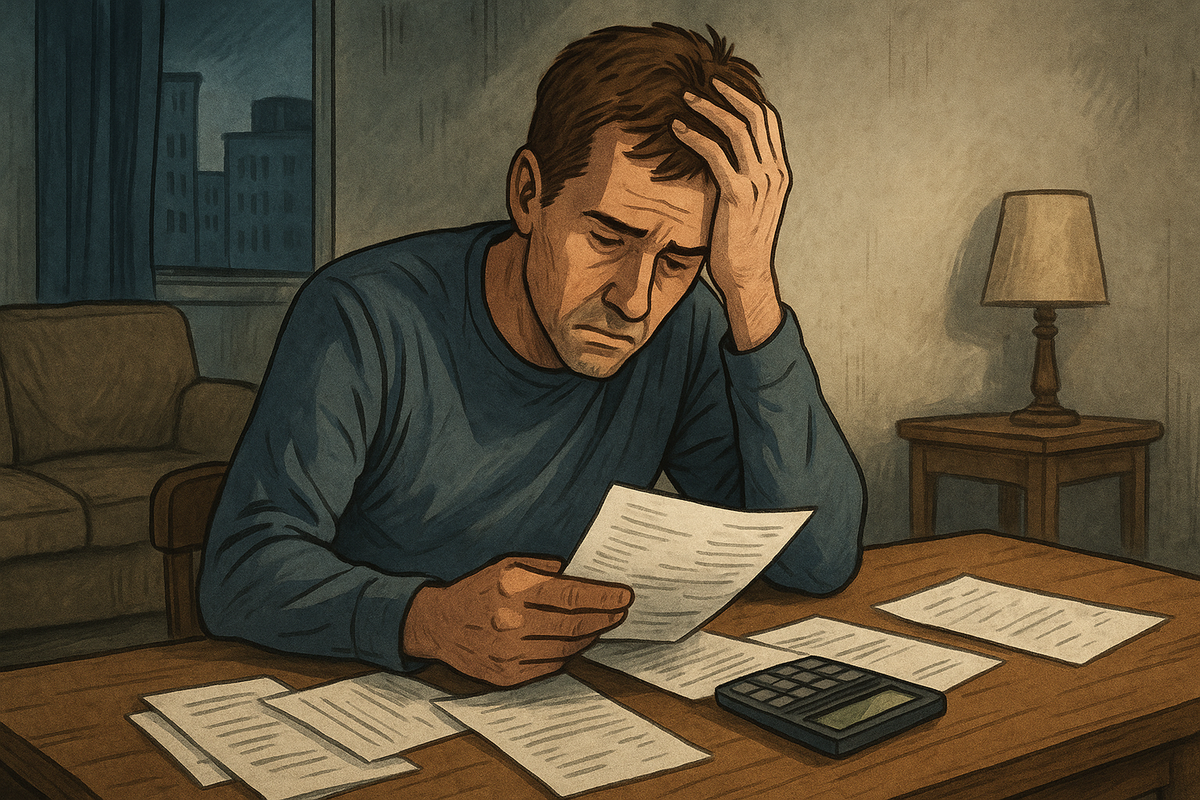Live paycheck to paycheck — it’s a daily reality for over 60% of Americans. To live paycheck to paycheck means constantly worrying about due dates, juggling bills, and knowing that one unexpected expense can trigger a crisis. This financial pattern affects everyone—from teachers and delivery drivers to software engineers and business owners.
But why do so many Americans live paycheck to paycheck, even with good jobs or decent incomes? How does this cycle begin—and more importantly, how can you stop living paycheck to paycheck before it takes a deeper toll on your future?
In this in-depth guide, you’ll discover 7 brutal but eye-opening reasons why people live paycheck to paycheck—and practical, proven strategies to break free. If you’re tired of the stress and want real solutions, this is the guide you’ve been waiting for.
Whether you’ve just started to live paycheck to paycheck or have struggled with financial insecurity for years, there is a way out. By understanding what causes this cycle—and how to shift your mindset, habits, and priorities—you can create lasting change and long-term stability.
Let’s explore why so many people live paycheck to paycheck, and what you can do—starting today—to take back control.

Contents
- 1 1. The High Cost of Living Is Crippling the Middle Class
- 2 2. Credit Culture Has Replaced True Affordability
- 3 3. Emergency Expenses Are Financial Wrecking Balls
- 4 4. Financial Illiteracy and Emotional Spending Are a Deadly Mix
- 5 5. Cultural Pressure and Lifestyle Inflation
- 6 6. Housing Costs That Cripple Stability
- 7 7. Job Insecurity and the Gig Economy
- 8 How to Break Free from the Paycheck-to-Paycheck Cycle
- 9 Bonus: 5 Common Myths About Living Paycheck to Paycheck
- 10 Final Thoughts: You Can Break Free from Living Paycheck to Paycheck
1. The High Cost of Living Is Crippling the Middle Class
- Rent: The national median rent rose by over 30% between 2020 and 2023, with cities like Miami and Austin seeing spikes above 45%.
- Groceries: The average grocery bill for a family of four has risen from $800/month in 2019 to over $1,050/month in 2024.
- Utilities: Gas, electricity, and water bills are now taking up more than 10% of income in many states.
Wages Aren’t Keeping Up—Not Even for Professionals
Even workers with college degrees and specialized skills are feeling the squeeze. According to BLS.gov, real wage growth has been essentially flat for over 20 years. While nominal salaries may look higher on paper, inflation has eroded their purchasing power significantly.
- Entry-level salaries haven’t adjusted to reflect housing costs in urban centers.
- Remote workers relocating to smaller cities have seen salary cuts—without a proportional drop in costs.
- Raises often don’t cover inflation, leaving employees effectively earning less.
Living paycheck to paycheck in this environment isn’t a personal failure—it’s a systemic imbalance between earnings and basic survival costs.
2. Credit Culture Has Replaced True Affordability
In today’s America, it’s easier to get approved for a $15,000 credit line than to save $500 in cash. Financial institutions, retail stores, and online platforms push credit solutions aggressively, often to people who are already financially vulnerable.
Credit as a Way of Life—Not a Backup
For many, credit cards are no longer a convenience or emergency tool—they’re a way to buy groceries, gas, medicine, and cover utility bills. When credit becomes a regular part of budgeting, it signals a deeper issue: your income isn’t enough to support your lifestyle or even basic needs.
- Over 60% of cardholders carry a balance month to month.
- Nearly 25% of U.S. adults used Buy Now, Pay Later services in 2023.
- Store cards with high APRs trap consumers with deferred interest fees.
Our article How Can People Owe $100,000 in Credit Card Debt? shows just how quickly credit use can spiral out of control when it replaces income.
The Hidden Cost of Credit: Compound Misery
High-interest debt eats into future paychecks. If you’re paying 20–30% APR, you’re effectively taxing your own income just to stay afloat. That makes building wealth almost impossible.
- $10,000 in credit card debt at 25% interest costs over $2,500 a year in interest alone.
- Paying minimums can stretch repayment into decades.
- Falling behind tanks your credit score, raising costs even more.
Living paycheck to paycheck becomes the default when every dollar you earn is already spoken for by past spending.
3. Emergency Expenses Are Financial Wrecking Balls
Imagine this: your car breaks down, you lose hours at work, or your child needs emergency dental care. For someone living paycheck to paycheck, that’s not an inconvenience—it’s a crisis.
57% of Americans Can’t Cover a $1,000 Emergency
This shocking statistic from Bankrate illustrates how financially fragile most people are. Without savings, every unexpected bill creates a new debt—or worse, leads to missed payments and fees.
- Car repair: A common $1,200 repair like a transmission issue can’t be postponed.
- Medical copay: Even with insurance, ER visits often require $500+ out of pocket.
- Lost income: Hourly workers lose pay for every sick day or emergency closure.
Emergency Funds Aren’t Optional—They’re Oxygen
Experts recommend saving 3 to 6 months of expenses. But for someone living paycheck to paycheck, that goal feels impossible. Start small:
- Open a high-yield savings account and automate $10–$25/week.
- Use tax refunds, cash-back apps, or side hustle income to build it faster.
- Sell unused items or cut subscriptions to create space for saving.
That first $1,000 changes everything. It gives you breathing room, bargaining power, and the ability to break the debt cycle.
In the next section of this article, we’ll go deeper into how poor financial education, cultural expectations, housing dynamics, and job insecurity play a major role in keeping Americans stuck in this fragile financial state.
Continue reading in Part 2 as we explore:
- Why financial literacy is dangerously lacking in the U.S.
- The real impact of lifestyle inflation and social comparison
- How unstable jobs make stable finances almost impossible
4. Financial Illiteracy and Emotional Spending Are a Deadly Mix
Most Americans were never taught how to manage money. Financial literacy isn’t part of the national curriculum in most states, and many parents didn’t have the knowledge to pass down either. This lack of understanding leads to confusion, stress—and poor decisions that reinforce the paycheck-to-paycheck trap.
What Financially Illiterate Choices Look Like
- Paying only the minimum balance on credit cards without understanding compound interest.
- Leasing vehicles perpetually instead of buying and maintaining one for the long term.
- Not contributing to employer-matched 401(k) plans—leaving free money on the table.
According to a report from the FINRA Foundation, 60% of Americans cannot answer basic questions about interest rates, inflation, or mortgage terms. This makes it easy to fall prey to predatory lenders, risky financial products, and scams.
From Emotional to Intentional Spending
Emotional spending—whether it’s comfort shopping or status-driven purchases—gives momentary relief but long-term regret. Shifting from impulsive behavior to value-based decisions helps redirect funds toward savings and debt reduction.
- Delay purchases by 24–48 hours before committing.
- Use budgeting tools like YNAB or EveryDollar to stay aligned with goals.
- Track every dollar spent for 30 days to identify money leaks.
5. Cultural Pressure and Lifestyle Inflation
In the age of social media, comparison is constant—and toxic. People feel compelled to display success by spending, even if their financial reality is unstable. This lifestyle inflation traps people in a never-ending cycle of overspending, often financed by credit.
The “Instagram Effect” on Your Wallet
- Weddings, vacations, and even daily outfits are often curated for likes, not affordability.
- Even modest earners feel pressure to keep up with luxury trends and aesthetics.
- Millennials and Gen Z feel the greatest pressure, with 40% admitting they overspend to keep up with peers.
This social pressure, combined with easy credit access, creates a deadly formula. Living paycheck to paycheck becomes a lifestyle choice, reinforced by digital culture—even when it’s unsustainable.
Redefining Success Financially
Success isn’t what you wear or drive—it’s how much freedom you have. By redirecting resources from performative consumption to practical priorities, you can escape the cycle.
- Create goals that align with your values (e.g., travel fund, early retirement, homeownership).
- Unfollow accounts that trigger insecurity or envy.
- Focus on building real wealth, not projecting fake affluence.
6. Housing Costs That Cripple Stability
Housing is the single largest expense for most Americans. Rent and mortgage costs are rising far faster than income. In major cities, rent consumes more than 50% of take-home pay—leaving little room for savings or emergencies.
The Rent Trap
- Median rent for a 1-bedroom in San Francisco exceeds $3,000/month.
- In many metros, rents jumped 20–40% from 2020–2023 alone.
- Renters have limited protection against sudden increases or eviction.
Meanwhile, buying a home is no easier. Prices surged post-pandemic, and mortgage rates in 2024 have hovered above 6.5%, making monthly payments unaffordable for most first-time buyers.
Breaking Free from Housing Strain
- Consider relocating to lower-cost areas if remote work allows.
- House hacking: Rent part of your home to offset costs.
- Explore rent-to-own or shared equity programs to bridge the homeownership gap.
7. Job Insecurity and the Gig Economy
Stable jobs with benefits are harder to find. Millions now rely on freelance, contract, or gig work—with unpredictable income and zero safety nets. Even salaried employees face layoffs, mergers, and downsizing at increasing rates.
Economic Instability = Personal Instability
- 60% of gig workers lack employer-provided health insurance.
- Only 25% have access to a retirement plan or paid sick leave.
- Variable income makes budgeting—and saving—nearly impossible.
Without a reliable income floor, even the best financial habits struggle to stick. The result? A constant cycle of catch-up, credit dependency, and survival mode.
Building Stability in an Unstable Job Market
- Diversify your income: Build a side hustle or freelance niche with long-term potential.
- Set up an income buffer: Save 1–2 months of expenses for slow periods.
- Seek roles that offer flexibility and stability—hybrid work, healthcare, or education sectors.
Now that we’ve explored the 7 brutal truths keeping Americans stuck in financial fragility, it’s time for the final and most important piece: solutions. In the next section, we’ll show you how to break the cycle of living paycheck to paycheck with real, practical steps anyone can start today.
How to Break Free from the Paycheck-to-Paycheck Cycle
Breaking free from the cycle of living paycheck to paycheck is not easy—but it’s absolutely possible. It requires a shift in mindset, smart financial habits, and systems that reduce chaos and create control. The following strategies can help anyone—regardless of income—rebuild stability and move toward long-term freedom.
Step 1: Track Every Dollar
You can’t change what you don’t track. Start by writing down every expense for 30 days. Use apps like Mint, YNAB (You Need a Budget), or even a simple spreadsheet. Understanding your spending habits reveals where leaks are draining your cash.
- Sort expenses into “Needs,” “Wants,” and “Waste” categories.
- Identify subscriptions, services, or habits you can pause or cut.
- Reallocate those savings toward debt, savings, or emergency funds.
Step 2: Build a Mini Emergency Fund
Before paying off all debt, set aside $1,000 as a buffer against emergencies. This helps prevent new debt when life throws a curveball.
- Use tax refunds, side hustle earnings, or monthly budgeting wins to fund it.
- Keep it in a separate high-yield savings account.
Step 3: Choose a Debt Payoff Method
- Snowball: Pay off smallest balance first for quick wins and motivation.
- Avalanche: Pay off highest interest debt first to save the most money.
Consider using secured loans or consolidation tools. Read our guide on whether a HELOC is right for debt consolidation.
Step 4: Increase Income Strategically
Cutting costs helps, but increasing income accelerates progress. Options include:
- Ask for a raise or take on more responsibilities.
- Start a freelance service using your skills (e.g., writing, design, tutoring).
- Use gig apps like DoorDash or Upwork to create flexible income streams.
Step 5: Automate Your Financial Life
Automation reduces decision fatigue. Set up automatic transfers for savings, bills, and investments so your money works for you before you can spend it impulsively.
- Automate retirement contributions (401(k), Roth IRA).
- Use auto-transfers to build savings effortlessly.
Bonus: 5 Common Myths About Living Paycheck to Paycheck
Myth #1: It Only Happens to Low-Income Earners
In truth, 45% of people earning over $100,000 per year still live paycheck to paycheck. Lifestyle inflation and debt don’t discriminate by salary.
Myth #2: It’s Just Poor Money Management
While budgeting mistakes matter, systemic issues like healthcare costs, wage stagnation, and housing inflation are larger forces at play.
Myth #3: You Can Budget Your Way Out of It
Budgeting is critical—but without income growth, debt relief, or lifestyle changes, it may not be enough. A multi-pronged strategy is necessary.
Myth #4: If You Work Hard, You Won’t Struggle
Millions of full-time workers still can’t afford basics. Effort alone isn’t always enough when structural barriers are in place.
Myth #5: It’s Always Your Fault
Living paycheck to paycheck is often the result of complex factors—economics, education, location, family responsibilities—not just individual choices.
Ready to take the next step? Explore our practical guide: 7 Smart Ways to Pay Off Credit Card Debt Fast.
Final Thoughts: You Can Break Free from Living Paycheck to Paycheck
Living paycheck to paycheck is not just about poor choices—it’s often the result of a system stacked against financial security. But understanding the root causes—rising costs, lack of financial education, cultural pressures, and unstable work—puts power back in your hands.
Remember: small, consistent actions compound over time. Whether it’s saving your first $100, setting up automatic bill payments, or eliminating one debt account, every step matters. You don’t need to have everything figured out—you just need to start. And if you live paycheck to paycheck today, know that you don’t have to tomorrow.
You Deserve More Than Just Getting By
- Revisit your relationship with money. Let go of guilt, shame, or comparison.
- Focus on progress, not perfection. One step forward each week adds up fast.
- Celebrate every win—however small. Momentum is built on success, not sacrifice.
Most importantly, know that you are not alone. Over 60% of Americans live paycheck to paycheck, but the number is shrinking—because more people are choosing to learn, act, and reclaim control. So if you live paycheck to paycheck now, use the resources here to start your turnaround.
Keep Going: More Resources to Help You Break Free
- How Can People Owe $100,000 in Credit Card Debt?
- 7 Smart Ways to Pay Off Credit Card Debt Fast
- Is a HELOC a Good Idea for Debt Consolidation?
- U.S. Bureau of Labor Statistics
- What Is Financial Literacy? – Investopedia
It’s your time to stop living paycheck to paycheck—once and for all.

Kaiya Acosta recently finished studying finance. He has always wanted to create a blog about money. Now, he is making his dream real. Kaiya is from Texas, USA, and loves helping people learn how to manage their money better.

